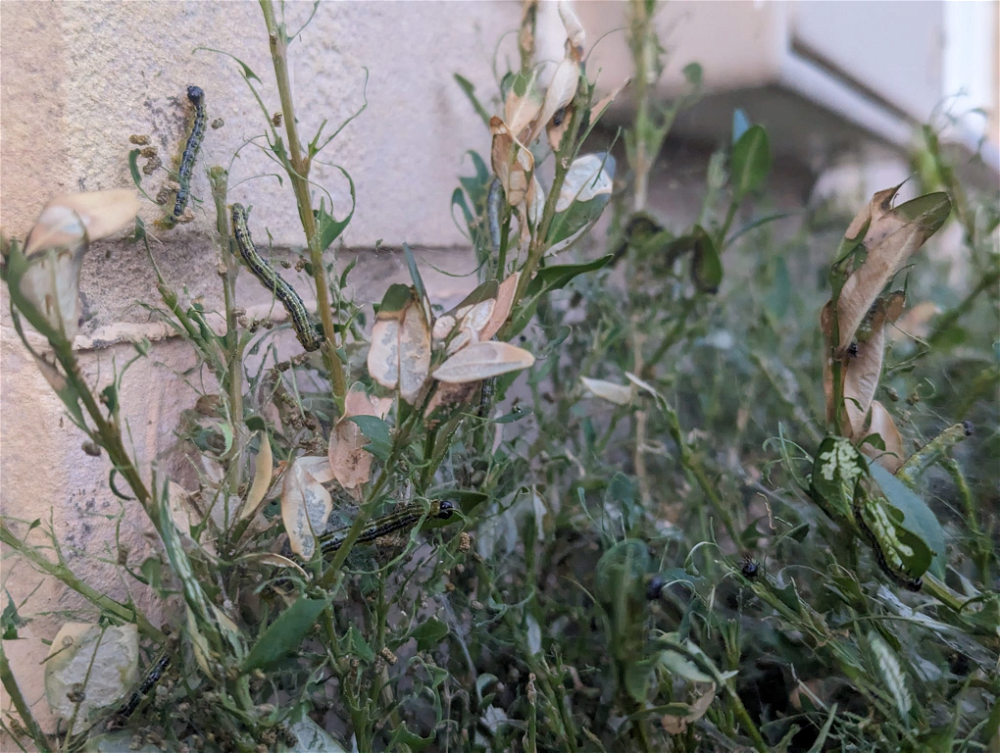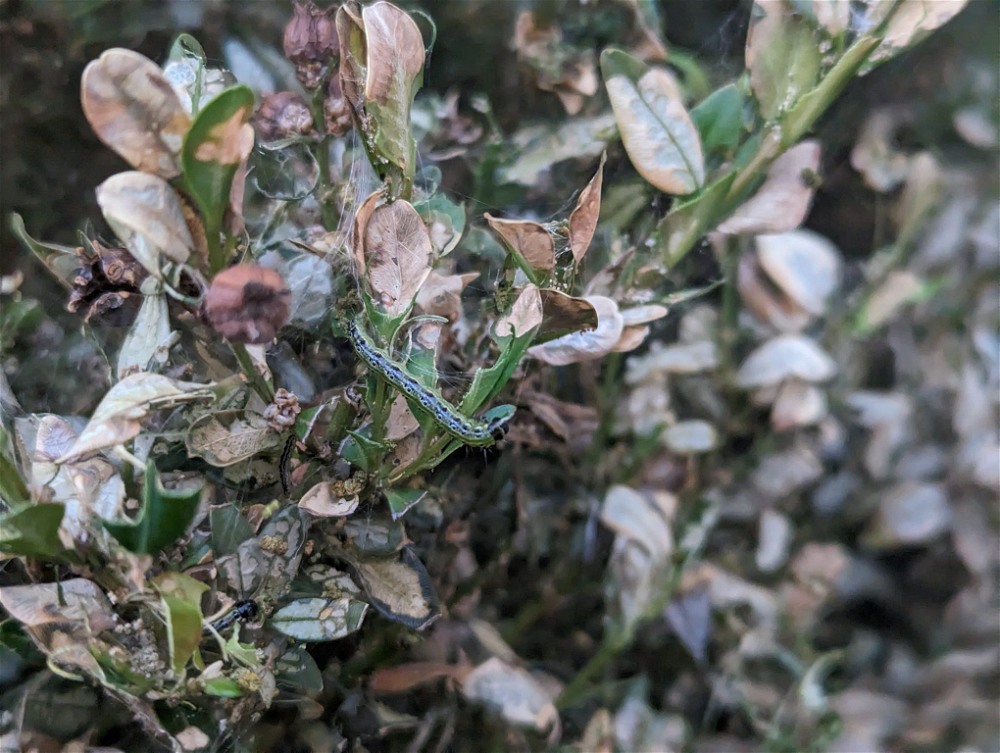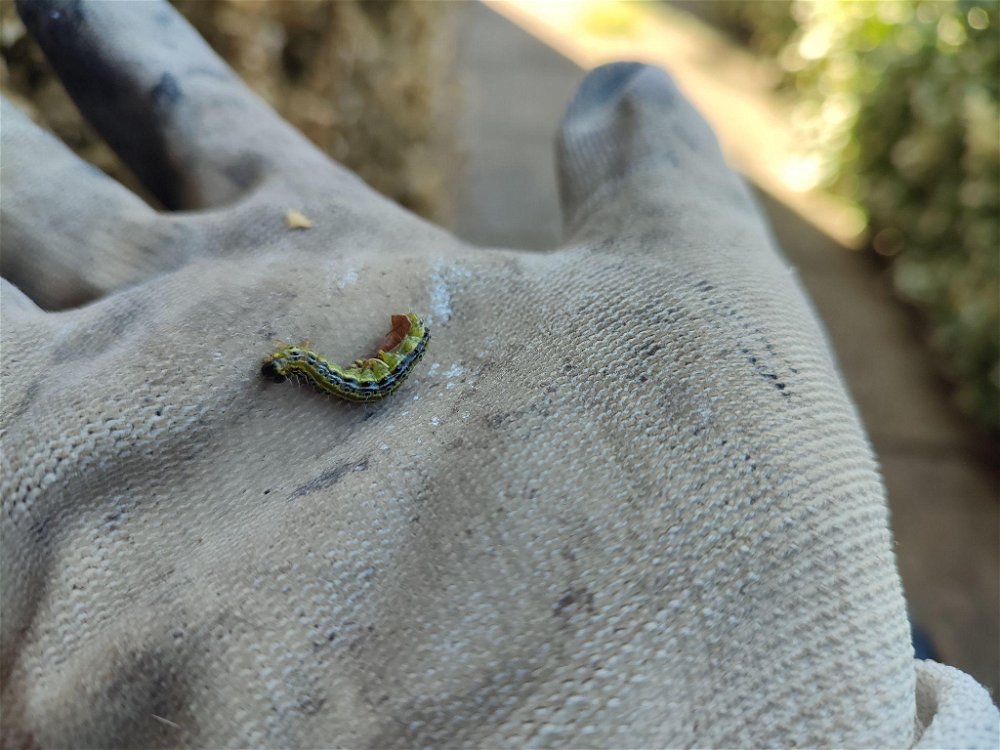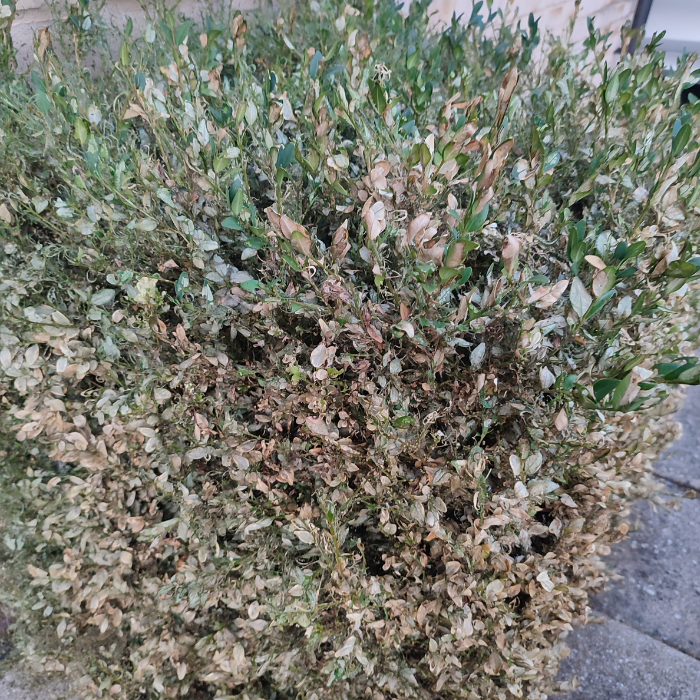
One week your boxwood hedge is fine. And the next? It’s covered in caterpillars.
If it’s your first time seeing these crawly creatures on your boxwood, you’re probably wondering what they are. Well, these are box caterpillars.
Unfortunately, boxwood hedges are susceptible to many pests, but the box tree moth is the most common in the UK.
If you’ve been hit with a box caterpillar infestation this year, you’re undoubtedly dying to know what to do about it. Follow this step-by-step guide to banish box caterpillars this summer.
What Is Box Caterpillar?
Box caterpillars are the larvae stage of the box tree moth, so they are also commonly known as box tree moth caterpillars.
The box caterpillar is a pest primarily targeting boxwood (Buxus) plants. We commonly use box plants for ornamental hedges and topiaries, so really, a pest infestation is the very last thing we want!
These pests can cause extreme damage to boxwood plants. In short, they strip them of their leaves, which weakens their overall health and destroys their well-kempt appearance.
With this in mind, it’s unsurprising that seeing a box caterpillar infestation can cause even an experienced gardener some stress, especially if their boxwood is in plain sight for all to see!
But how do you know it’s a box caterpillar infestation? To recognise this, you need to know the signs.
What Are the Signs of a Box Caterpillar Infestation?
Box caterpillars typically emerge when the temperature begins to warm up. So, keep an eye out for the signs during spring and summer.
A box caterpillar infestation can cause visible damage to boxwood plants, so this is the first sign to look out for. As box caterpillars defoliate the plant, check for a loss of leaves or visible munch marks.
As box caterpillars feed on the leaves, they tend to leave behind skeletonised leaves with only the veins remaining. This can give the plant a web-like appearance, as the caterpillars consume all of the soft tissue between the veins.
When your boxwood is infested, you’ll also notice webbing in areas of your plant, typically beside feeding spots. This webbing might be visible in the form of silken threads that bind leaves together or cover sections of the plant.
And, of course, it’s important to keep a lookout for the little pests themselves. The box caterpillar has distinctive black and green stripes along its body, making it an easy one to identify.
If your boxwood infestation is severe, you’ll notice your plant browning and dying back. This happens due to defoliation, as this makes it difficult for the plant to produce enough energy through photosynthesis.
Step-By-Step Guide to Getting Rid of Box Caterpillar
While a box caterpillar infestation can sound a bit bleak, there’s good news. There are plenty of methods we can use to banish the box caterpillar, reducing the damage to our boxwoods and putting them off the following spring and summer. So, let’s get to it!
1. Step One: Use Organic Control Methods
Organic control methods may be the best route to go down if you catch an infestation early on. You can tell when you’ve caught it early because the damage to your boxwood plant is minimal. Perhaps you’ve noticed a few caterpillars appear, or you’ve seen some defoliation, but the majority of the plant’s leaves are still intact.
At this point, it could be easy to think the caterpillars won’t cause much damage, and they’ll go away on their own. But trust me; this isn’t the case – I’m talking from past experience here! It’s important to act straight away to minimise the damage. So, what can you do?
The three main organic control methods are:
- Pheromone traps
- Hand removal
- Biological insecticide
Let’s go through each in turn.
Using Pheromone Traps on Box Tree Moths
Pheromone traps are an excellent idea if you’ve noticed a moth or two and want to keep an eye on them.
This control method has two pheromone lures that act as a female moth, attracting male box tree moths. Once the trap has lured them in, they drop through the funnel and into the trap.
Pheromone traps can help to control the presence of moths and reduce the likelihood of them laying eggs on your boxwood. However, they won’t solve the problem once you have caterpillars. Therefore, this method is only helpful right in the early stages.
Removing Box Caterpillars By Hand
OK, so hand removal doesn’t sound all that fun. But when you’ve noticed the start of an infestation, hand removal may be all you need to control their numbers. Simply put on some protective gloves and get to work, removing each caterpillar by hand.
Ensure you prepare a bucket of water beforehand to dispose of these pests, as squishing each individual one could leave an awful lot of cleanup and doesn’t sound particularly pleasant!
If you’re like me and hate killing any animal, you may be disinclined to “dispose” of them using either of these methods. Unfortunately, box caterpillars leave you few alternative options! While you could normally leave caterpillars and other insects out for the birds, our native birds don’t like box caterpillars much.
You see, boxwood plants contain toxins in their leaves, so when box caterpillars gorge on them, the caterpillars quickly become poisonous themselves. As a result, the birds tend to stay away!
Applying Biological Insecticide to Boxwoods
Pheromone traps and manual removal can only do so much to get rid of box caterpillars. When these aren’t sufficient, you’ll need an insecticide. The most environmentally friendly of these options is a biological insecticide, also known as a natural or organic insecticide.
Biological insecticides are non-synthetic, meaning they break down rapidly, reducing the likelihood of harming any animals besides the box caterpillars themselves. Normally, this leaves any native birds or bees out of harm’s way.
TOPBUXUS Xentari is the best biological insecticide for the job. After using this on my box hedge in the past, the caterpillars stopped eating the treated leaves within several hours, and the damage rapidly reduced as the caterpillars began to die off (within a couple of days).
There’s one downside of biological insecticides – they aren’t as potent as the chemical alternatives and so will need to be reapplied several times to truly cause any damage to these unruly pests. However, if you buy TOPBUXUS Xentari, the necessary retreatments are limited. I used this product 3 times on my box hedge, and it worked a treat. Here’s how to use it:
- Dissolve 3 grams of Xentari granules for every 30 litres of water. This will cover around 30 m² of boxwood surface. If you have a bigger hedge, simply mix up some more!
- Use a clean, disinfected spray bottle to apply Xentari. Spray it as soon as you notice the first caterpillars on your box hedge, both on the top surfaces of the leaves and the undersides, too.
- Wait a couple of days for the insecticide to work its magic. During this time, the box caterpillars will eat the protein crystals Xentari contains. These crystals damage the caterpillar’s gut cells, eventually causing blood poisoning and death within 1 – 3 days.
- Repeat the treatment in 1 – 2 weeks’ time.
- Then, retreat your box hedge in winter in the run-up to spring to prevent another infestation.
Xentari may not be available in your local garden centre, but it is readily available online.
2. Step Two: Switch to Chemical Insecticides
The final control method is a chemical (or “synthetic”) insecticide. I don’t typically use or recommend chemical insecticides due to the potential damage they can do to other animals and plants.
However, if you’ve caught your infestation late and your boxwood’s life hangs in the balance (like mine has in the past!), then it may be worth using a chemical insecticide. But a word of warning – you should only use chemical insecticides minimally and in a highly targeted way. Here’s how to do this:
- Read the instructions on the packaging before applying any chemical insecticide, and wear the recommended safety gear.
- Spray your boxwood with a store-bought chemical insecticide as soon as you notice any damage. This could be as early as March all the way to late September.
- Spray the whole plant, including the undersides and tops of the leaves, as well as any plants directly beside your affected boxwood. However, DO NOT spray any flowering plants, as a chemical insecticide doesn’t only kill caterpillars – it will kill pollinators like bees, too.
- Spray again at the end of the summer to kill off any remaining caterpillars.
- Spray once more at the end of winter. This will catch your box tree moths early, preventing them from damaging your boxwood the following year.
Bug Clear Ultra, Westland Resolva Bug Killer and Py Bug Killer are the best choices of chemical insecticides for tackling box caterpillars. Some garden centres may refer you to Provanto Ultimate Bug Killer, but I advise against it. It was extremely ineffective for box caterpillars when I used it in the past. Never again!
3. Step Three: Prevent Box Caterpillar Infestations Next Spring
Unfortunately, box caterpillars can return year after year. So, how are you going to stop the infestation next year?
We can get ahead of the game by frequently checking our box plants from early spring. Even if there are no signs early on, it’s important to keep checking, as these pests can show up at any time in spring or summer.
Another action to take is to use a pheromone trap. Have these up around your boxwood to attract any male moths away from your plants. Installing traps won’t be the only step you need to take, but they’ll give you a heads-up to get your gloves on or an insecticide at the ready.
And finally, remember to be vigilant. Box tree caterpillars can be sneaky, hiding in your boxwood until it’s too late. Keep an eye on your boxwood from spring onwards, checking behind the leaves, in the centre of the plant, and around the base.
FAQs
How do I get rid of caterpillars in my box hedge?
You can get rid of the first presence of moths using pheromone traps. You can remove caterpillars by hand picking them out or using a biological insecticide. But if the infestation is severe, you may need to draft in a handy organic or synthetic insecticide.
Can box hedge recover from box caterpillar?
Yes, box hedges can recover from damage caused by box caterpillar infestations, but the extent of recovery depends on the severity of the damage, the plant’s health, and the care you give it after it has been infested.
What time of year do box caterpillars come out?
Box caterpillars typically emerge and become active during the warmer months of the year. The exact timing can vary depending on the climate conditions and where you are in the UK. But generally, you can expect box caterpillars to start emerging in the UK during the spring (around April/May) and continue through the summer months.
Do box caterpillars come back every year?
Yes, box caterpillars can (but don’t always) come back every year. The box caterpillar is the larval stage of the box tree moth. The moth’s life cycle involves multiple generations each year. The adult moths lay their eggs on the leaves of boxwood plants during the warmer months, typically from spring to early autumn. The eggs hatch into caterpillars, which feed on the leaves of the boxwood, causing significant damage if left unchecked.
The caterpillars go through several stages of growth before pupating into adult moths. The pupae can overwinter in debris around the plants, and when the weather warms up again, they emerge as adult moths, ready to lay eggs and start the cycle anew.
What is the best box hedge caterpillar killer?
The most effective methods for controlling box hedge caterpillars are preventative measures – pheromone traps for moths and hand-picking for caterpillars. However, if you don’t catch the infestation quickly, an insecticide is the best method for killing box hedge caterpillars.





